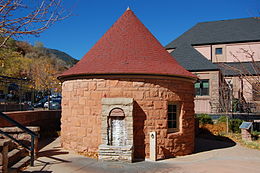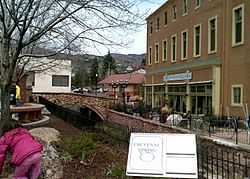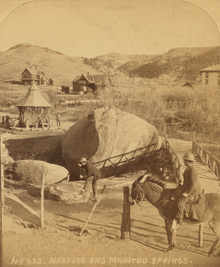
Manitou Springs is a home rule municipality located at the foot of Pikes Peak in western El Paso County, Colorado, United States. The town was founded for its natural mineral springs. The downtown area continues to be of interest to travelers, particularly in the summer, with many shops and restaurants, as well as a creekside city park. The main road through the center of town was one of the direct paths to the base of Pikes Peak. Barr Trail, which winds its way up Pikes Peak, is accessible from town. The subdivision Crystal Hills was added to the municipality in the 1960s.

Garden of the Gods is a 1,341.3 acre public park located in Colorado Springs, Colorado, United States. 862 acres of the park was designated a National Natural Landmark in 1971.
The Ute Pass is a mountain pass west of Colorado Springs that ranges from a peak elevation at Divide of 9,165 to 6,165 feet at its lowest point.

Cascade is an unincorporated community and U.S. Post Office in El Paso County, Colorado, United States. The ZIP Code of the Cascade Post Office is 80809.

Before it was founded, the site of modern-day Colorado Springs, Colorado, was part of the American frontier. Old Colorado City, built in 1859 during the Pike's Peak Gold Rush was the Colorado Territory capital. The town of Colorado Springs was founded by General William Jackson Palmer as a resort town. Old Colorado City was annexed into Colorado Springs. Railroads brought tourists and visitors to the area from other parts of the United States and abroad. The city was noted for junctions for seven railways: Denver and Rio Grande (1870), Denver and New Orleans Manitou Branch (1882), Colorado Midland (1886-1918), Colorado Springs and Interurban, Atchison, Topeka, and Santa Fe (1889), Rock Island (1889), and Colorado Springs and Cripple Creek Railways. It was also known for mining exchanges and brokers for the Cripple Creek Gold Rush.

Barr Trail is a 13-mile (21 km) trail in the Pike National Forest that begins in Manitou Springs, Colorado and ends at the Pikes Peak summit. The high elevation trail with a long sustained grade is rated more difficult by the U.S. Forest Service. With a 7,800 feet (2,400 m) elevation gain to reach the summit, the Colorado Springs Convention & Visitors Bureau states that it is an advanced trail and is the most difficult trail in the Pikes Peak region.

Briarhurst Manor, also known as William A. Bell House, is a finely grained pink Victorian sandstone manor house listed on the National Register of Historic Places in the city of Manitou Springs, Colorado. It is the second building on this site.

George Frederick Ruxton was a British explorer and travel writer. He was a lieutenant in the British Army, received a medal for gallantry from Queen Isabella II of Spain, was a hunter and explorer and published papers and books about his travels to Africa, Canada, Mexico and the United States.

The Uncompahgre Ute or ꞌAkaꞌ-páa-gharʉrʉ Núuchi is a band of the Ute, a Native American tribe located in the US states of Colorado and Utah. In the Ute language, uncompahgre means "rocks that make water red." The band was formerly called the Tabeguache.
Ivywild, Colorado, is a subdivision of Colorado Springs south of the downtown, west of Cascade Avenue and along Cheyenne Creek. As of 2015, the United States Geological Survey defines Ivywild as a Populated Place. It is one of the city's oldest working-class neighborhoods.
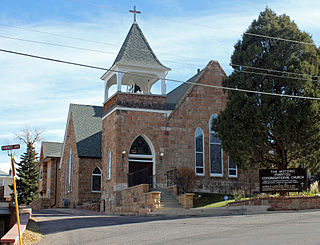
First Congregational Church is a historic church at 101 Pawnee Avenue in Manitou Springs, Colorado. Completed in August 1880, it was the first church built in Manitou Springs and is the oldest continuously operated Congregational church in Colorado. Due to an influx of tourists during the summer, it was enlarged in 1891. It was added to the National Register of Historic Places in 1979.

Manitou Springs Historic District in Manitou Springs, Colorado is roughly bounded by US 24, Ruxton Avenue, El Paso Boulevard and Iron Mountain Avenue. Listed in the National Register of Historic Places, it is one of the country's largest National Historic Districts.

Cliff House in Manitou Springs, Colorado is a Queen Anne style hotel in the Manitou Springs Historic District. It is a National Register of Historic Places listing. The Cliff House at Pikes Peak is a member of Historic Hotels of America, the official program of the National Trust for Historic Preservation.

Manitou Bathhouse or Manitou Spa is a historic building located along Fountain Creek in Manitou Springs, Colorado. Once used as a mineral water bathhouse or spa, the building is now used for stores and other businesses on the first floor. The second and third floors hold residential units. It is on the National Register of Historic Places. Located in the building is Adam's Mountain Cafe.

US Post Office-Manitou Springs Main or Manitou Springs Post Office is a historic building located on Canon Avenue in Manitou Springs, Colorado. It is on the National Register of Historic Places.

Iron Springs, a neighborhood in Manitou Springs, Colorado, was an area named for one of Manitou Mineral Springs. The Manitou area had been frequented by Native Americans who considered it a sacred and healing place before European Americans settled in Manitou.
Englemann Canyon is a valley along Ruxton Creek, in Manitou Springs, El Paso County, Colorado. It is one of three canyons in Manitou Springs, the others are Ute Pass and Williams Canyon.

The Colorado Springs and Interurban Railway was an electric trolley system in the Colorado Springs, Colorado area that operated from 1902 to 1932. The company was formed when Winfield Scott Stratton purchased Colorado Springs Rapid Transit Railway in 1901 and consolidated it in 1902 with the Colorado Springs & Suburban Railway Company. It operated in Colorado Springs, its suburbs, and Manitou Springs. One of the street cars from Stratton's first order is listed on the Colorado State Register of Historic Properties.
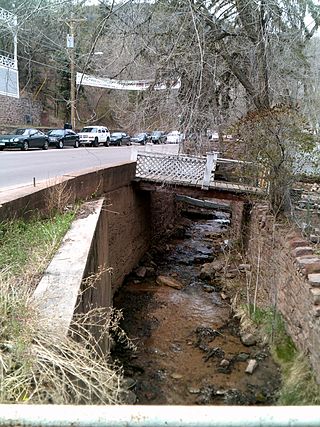
Ruxton Creek is a stream in Manitou Springs in El Paso County, Colorado. Named for British explorer and writer of the southwest, George Fredrick Augustus Ruxton, it is one of three main drainage basins in Manitou Springs. Ruxton Creek flows out of Englemann Canyon and into the town of Manitou Springs. Iron Springs geyser emanates from the creek and is one of the Manitou Mineral Springs.
